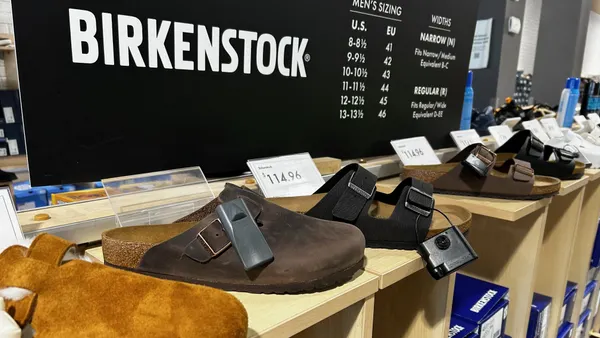Dive Brief:
- Sears Holdings anticipates a year-over-year improvement in earnings for the fourth quarter, the company said in a regulatory filing Thursday. Management projects earnings before interest, taxes, depreciation and amortization (or EBITDA) to fall somewhere between a $10 million loss and positive $10 million, as compared to a $61 million loss in the prior year's Q4. Along with cost cuts, Sears got help from a tax benefit of up to $495 million in Q4, a result of the recent tax bill. That could lift net income to between $140 million to $240 million, compared to a net loss of $607 million in the year-ago period, the company said.
- Stockholders liked the news, with Sears stock trading up nearly 25% at its peak on Thursday. But even as Sears improved the bottom line in Q4, its sales performance was terrible. Comparable store sales declined by 15.6%, with Kmart comps falling 12.2% and Sears' domestic store comps falling a frightful 18.1%. At $4.4 billion, Sears' top-line sales fell by about 33%, a figure that captures both store closures and continued hemorrhaging in Sears' sales base.
- In the same filing, the retailer said it had begun an exchange for two groups of bonds due in 2018 and 2019. Sears said in January it would offer shares of company stock in exchange for specified debt amounts.
Dive Insight:
So far in 2018, the Sears story remains roughly the same: shuttered stores, cost cuts and incremental financial maneuvers. As a direct result of all these moves in recent years, the company has shrunk at an astonishing pace. And at least partly as a result, the company's sales continue to collapse.
To be sure, Sears needs to get its balance sheet under control. The retailer noted the relative improvement came amid "challenges in the retail environment" and demonstrated "that the restructuring actions taken in 2017, including the closure of unprofitable stores, have resulted in meaningful improvement in our performance."
The company has pledged to return to profitability in 2018 — and it did indeed make significant progress in reducing its losses for much of 2017. But it's still at risk of losing money in Q4, and borrowing heavily as it goes.
"Sears is taking additional steps to address its upcoming maturities in fiscal 2018 and improve its liquidity as its unencumbered asset base continues to decline and its business turnaround remains elusive," Moody's Vice President Christina Boni said after the company released initial figures for the holiday period. "Despite brighter sales in the department store sector this holiday season, Sears continued to significantly under perform [on comps]."
Sears has been able to stave off default for years largely through store closures (there have been around 400 in the past year alone), staff layoffs (numbering in the hundreds in 2017), asset sales, loan extensions and loans from Lampert's hedge fund ESL Investments, which provided hundreds of millions of dollars in credit in 2017. To try to revive sales, it's also partnered with Amazon to sell Kenmore products, tested new store formats, revived its holiday catalog and has continued tinkering with its Shop Your Way loyalty program, adding perks like Uber and, more recently, video services to entice customers.
But Sears needs to get comparable store sales under control if hopes to survive. The dwindling sales might be the bigger problem in the long run. A retailer can only cut costs and close stores so much and remain viable. And there seems to be no end in sight to the customer bleeding.
"In essence, the whole group [of Sears store lines] remains in a tailspin, and it is clear that there is no chance of even a leveling-off in sales anytime soon," Neil Saunders, managing director of GlobalData Retail, wrote in November (and things at Sears have changed little since). "The dramatic loss of customers at existing stores continues apace, and we believe that there is a danger this trend could accelerate into the new year."














